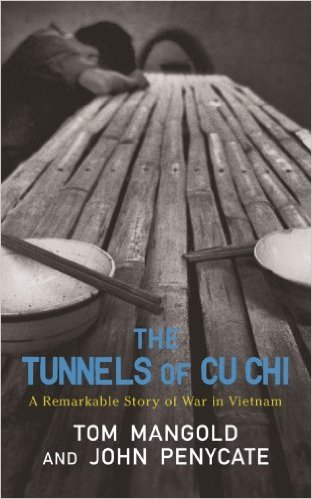The Tunnels of Cu Chi
A harrowing account of America’s “Tunnel Rats” in the underground battlefields of Vietnam, by Tom Mangold & John Penycate – Ballantine Books.
A friend asked me to read this book and I am glad I did. Not that it gave any pleasure but because none of us should forget these sad historical events or let them slide into the past. Also we should not let the current and seemingly perpetual excesses of military violence disappear into history without some reflection.
I did reflect and ask, why are we, the human species, still so warlike and tribal and nationalistically inclined and in reality so conditioned against those who are not on ‘our side’.
It is anachronistic to pit Capitalism against Communism in this age when both extremes are beginning to understand they must accommodate a new world disposition where inter-dependancy, mass-communications, education, de-centralisation and increasing social awareness are tearing down the walls of imperialism and neo-colonisation by non-state agglutinations of corporations.
The Vietnamese had been fighting for generations, against the Chinese, the Japanese, the French and then the armies of the USA and willing allies. Of course the Vietnamese fought to hold fast to their land and what was left of their way of life and with such tenacity.
To read the Amazon sales blurb associated with the book, the pro-USA commonly espoused bias becomes clear where, “the Tunnel Rats were G.I.s of legendary skills and courage” and the Viet Cong, were, “… a cruel and ingenious enemy”.
The book is much more balanced and goes to valid sources to detail the way the locals dug in with spectacular success and how the occupiers gradually gained more and more expertise thereby developing what became known as the Tunnel Rats – experts and valiant ones too if sides are to be taken, with many a heroic tough-guy story to tell from among the invaders.
No matter how many anecdotes were culled from the adventures of the Tunnel Rats, their exploits pale in comparison to the magnificent defensive measures taken by the Vietnamese who had the moral right of the protection of their land and peoples against foreign invasion and the attempted occupation by a major power.
The valiant surgeon Dr. Vo Hoang Le tells his tale of unending improvisation while working in impossible underground conditions.
The entertainer – yes there were entertainment troupes in the tunnels, over the long term as well – Pham Sang tells how he surpassed his entertainment role to become a soldier in the end.
Further anecdotes come from such as Vo Thi Mo, the girl guerrilla, and her band of fighting sisters actively soldering along with the ‘boys’.
But importantly for me, to learn quite clearly that the Vietnamese are as deeply patriotic of their way of life, their land, and their loves, as any other national and to learn how they related and helped each other and died for each other.
It is impressive to learn that Communists, despite going to extremes of one sort or another, are good people with workable plans to extricate their countrymen from endemic poverty, from corruption, and especially from the excesses of capitalist adventurism carried out to such an exemplary style in the USA’s military camps with all their comparatively luxurious provisions and facilities, while the Vietnamese secreted themselves below ground in the very dirt of their land.
A scorched earth policy with napalm and 500 pound bombs that left 30 foot deep craters, poisonous gases, C4 explosives and psychological warfare pummeled the Vietnamese fighters but never stopped their military activities and in the end the constant harassment by the defenders brought down the mighty US war machine, who simply pulled out.
No one won.






